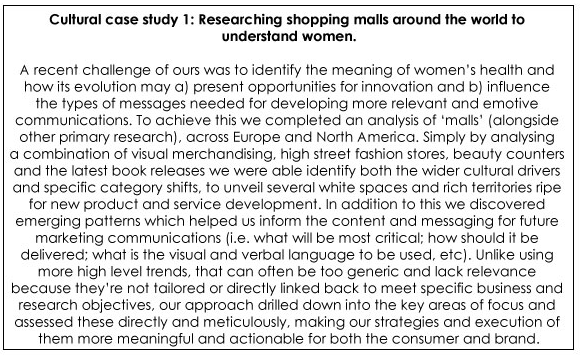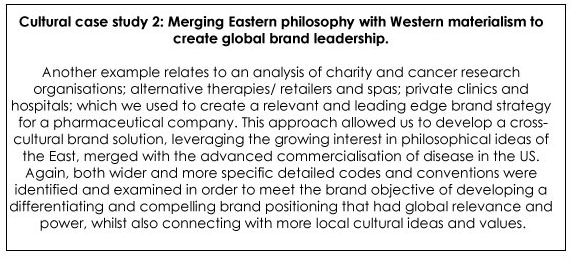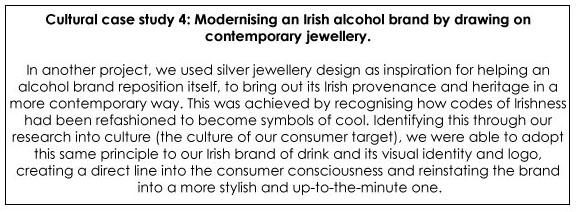Leanne Tomasevic
Culture speaks to us of our identity, our relationships and our behaviours. It drives and shapes our needs and wants. Yet as researchers, we rarely bother to look into this cultural world: the place where brands and objects create and provide meaning to everyday life.
Why is culture important?
To understand people and what they do, we need to understand the wider and much bigger picture of everyday life and the world we live in: namely culture. It is only when we understand the cultural frameworks that people use to make sense of daily life, that consumer behaviour becomes truly meaningful.
To go beyond spending time with consumers to consider the broader cultural frames, we are able to do much more than simply ask, listen and watch, we can actually direct the consumer change we want to see, more closely aligning our research and understanding with what we need to deliver to meet our marketing and commercial objectives.
As Doug Holt in Harvard Business Review puts it: “Knowledge doesn’t come from… the marketer’s usual means for ‘getting close to the consumer’. Rather, it comes from a cultural historian’s understanding of ideology as it waxes and wanes, a sociologist’s charting of the topography of contradictions the ideology products, and a literary critic’s expedition into the culture that engages these contradictions.”
Key point 1: Culture provides marketers with knowledge they can use to inform and direct the consumer change they wish to see.
In fact, such a cultural approach actually takes us two steps further in terms of our development in consumer behaviour, because it also shows us how to create the consumer world itself. We only need to look at HSBC who now perceptually own the narrow boarding walk into aeroplanes; or celebrity brands such as Radiohead who have produced a newspaper that is distributed in 61 cities across the world. There is no doubt brands occupy an increasingly prominent place in the cultural landscape, influencing what we think and how we behave. It is what Mike Featherstone in Consumer Culture and Postmodernism calls “the aestheticization of everyday life”.
Key point 2: Cultural insight helps to demonstrate the importance of, and potential for, how brands create the consumer world we live in.
We can take this even further again, making it the third step to advancing our understanding of consumers, as cultural knowledge enables us to not only direct consumer change and show us how to change it, but it also helps us change consumer behaviour itself. Take the iPhone for example, another omnipresent illustration of culture which across the world has changed how we do things.
Not only did it change us from pushing and pressing to swiping and tapping, but it has enabled us to pull off the ingredients we need from a Jamie Oliver recipe whilst we are strolling around the supermarket and has led to many more accidents as we bump into things whilst trying to text and walk at the same time. These are all new behaviours that a little object – a piece of consumer culture – has made us do, changing our expectations and potentially what we need and want.
Key point 3: The everyday stuff we interact with is a key part of culture, all products/services and brands play a powerful role in influencing how we behave.
So, if we fail to take this wider cultural context into account we will continue to narrow our focus to the point of making the individual the only locus of meaning and significance. But talking to people is not the only way to discover and capture all the information we need about the decision-making process. Actually, most of what influences what we buy and why we buy it, is a result, not of what consumers can consciously say, but most critically, a result of what has gone on around them; what they have been using and doing, and what they have been seeing, hearing and communicating.
Key point 4: Consumers can tell us what is inside their heads, but they cannot reveal the more unconscious influences that drive and shape their thoughts and ideas and ultimate reasoning behind their purchase decisions.
Therefore, to authentically understand consumers, we need to understand why they have what they have in their minds and where these meanings have come from in the first place. Using cultural knowledge to inform us of these meanings will ensure the brands we bring to market fit within the cultural frameworks of how people make sense of daily life.
Daniel Miller, Professor of Anthropology, neatly sums this up in his book Stuff, by explaining that “much of what makes us what we are exists, not through our consciousness or body, but as an exterior environment that habituates and prompts us.”
Key point 5: It is important to understand how brands and objects fit into the cultural frameworks of everyday life, influencing and prompting us to think and behave in different ways.
How do we understand culture?
So when we say we need to research and leverage cultural knowledge, we are referring to essentially everything in our cultural world, which can literally be anything someone comes into contact with, and/or interacts with, in day to day life.
General examples of this and the specifics of what we analyse can include any of the following: an exhibition, new technology, packaging design, advertisement, fashion, retail outlet, camera, drink, musical artist, fictional writer, blog and as you can see, the list could go on and on.
This cultural approach centres on, and connects us with, consumers in a meaningful way, providing a multilayered understanding that informs us about how the world is changing and how consumers are changing, and in a form that is much more intimate and relevant than cool-hunting, trends, or the snapshot of a consumer conversation.
An example of how we can gain this more textured and personal understanding of consumers, as well as identifying how they and the consumer world is likely to evolve, is highlighted in several recent studies shown here.
So What does this mean for research?
All of these examples demonstrate how an examination of culture can help us to better understand consumers and what sits behind their needs and wants, giving us clues to what lies ahead and the ability to mould and build new brands that reflect, shape and lead this cultural space.
Cultural insight on the one hand opens us up and takes us into a new world full of fresh perspective and knowledge, yet at the same time, it manages to bring us so incredibly close, that it give us a deep and intimate understanding of people and brands.
Whilst more established and traditional research methods become fragmented through their focus on the individual, an analysis of culture is able to achieve a more holistic view because it has its attention on the bigger picture, understanding how attitudes and behaviours fit into the larger framework of people’s lives, to determine what will make sense to them and ultimately what they buy.
In a nutshell, cultural insight stretches our thinking and shows the consumer world to us in a new and exciting way, revealing a more dynamic and multi-faceted view that is able to draw us in more powerfully. Analysing culture allows us to get to know consumers better, because it shows us who we are. It shapes our identities, our relationships and our everyday practices. We must research culture if we want to genuinely understand consumers and influence their behaviour.
Leanne Tomasevic is MD of Truth Consulting’s London office. She will be speaking at this years ESOMAR Congress in Istanbul. For more information and to register for the event, visit the ESOMAR event pages.







1 comment
[…] To read the full article, please click here: /2013/08/25/why-cultural-stuff-matters/ […]